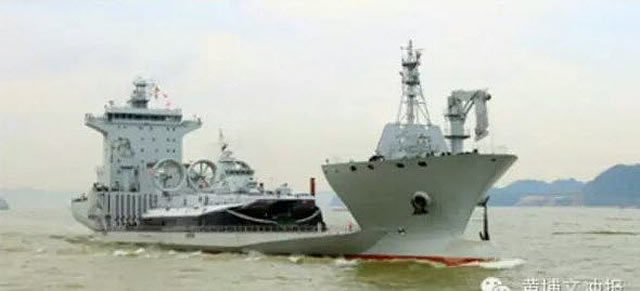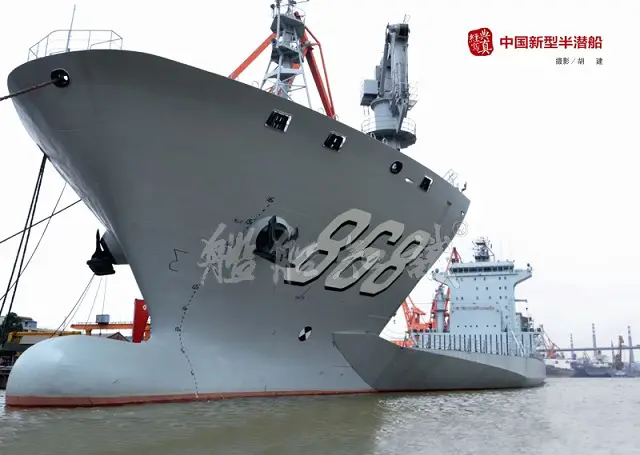Breaking news
Chinese Navy (PLAN) Took Delivery of a Vessel Similar to US Navy's Mobile Landing Platform (MLP).
| 2015
| |
|||
| a | |||
Naval Forces News - China |
|||
Chinese
Navy (PLAN) Took Delivery of a Vessel Similar to US Navy's Mobile Landing
Platform (MLP) |
|||
According
to several local papers, the People's Liberation Army Navy (PLAN or
Chinese Navy) received the first of a new class of vessels with allegedly
similar capabilities as the US Navy's new Mobile Landing Platform or
MLP. But how much do the two types really share in common ? |
|||
 Vessel 868 is seen transporting a Zubr class (Project 12322) LCAC in this official picture from the shipyard in charge of the building the vessel. |
|||
The
vessel with hull number 868 (its project number hasn't been disclosed
yet) was delivered to the PLAN on June 26th by Huangpu Shipyard located
in Guangzhou (member of CSSC China State Shipbuilding Corporation).
It allegedly was launched in February this year and completed sea trials
in just a couple of month. Its main mission will likely be transporting
and projecting the Zubr class (Project 12322) recently
acquired by the PLAN. |
 Based on this CGI, the new semi-submersible vessel of the PLAN can tranport LCAC and Submarines alike. |
|||
Like
the US Navy Montford Point class MLP, vessel 868 has the ability to "ballast
down": its hull sinks in the water just enough to allow the air cushion
craft to float and sail off. But the two types are not exactly in the
same category: At over 60,000 tons, the MLP dwarfs vessel 868 and its
reported displacement of around 15,000 tons. And despite being based on
the hull of the civilian Alaska-class oil tanker, MLPs are complex vessel:
It takes their builder, General Dynamics NASSCO, a full year to build
and a couple years of sea trials with the US Navy to fully test the vessel.
Vessel 868 and its couple months of testing appears as a much simpler design. It may well just be a civilian semi-submersible medium lift ship painted grey. Such vessels are often used to transport vessels, submarines or oil rigs, such as the MV Blue Marlin. In comparison, the Montford Point class is fitted with all the equipment necessary to accommodate 3 LCAC and their crew. Because of its small size, vessel 868 may not be able to "base at sea" a Zubr (or another equipment) for an sustained period of time. Because of its limited size too, loading or off loading vehicles on and off the Zubr, via vessel 868 appears impossible. |
|||
 Vessel 868 was delivered to the PLAN on June 26th. This shot shows it is clearly smaller than the US Navy's Montford Point class MLP. |
|||
The Montford Point class MLP is a highly flexible platform that may be
used across a broad range of military operations, supporting and executing
a variety of missions including humanitarian support and sustainment of
traditional military missions. The ship is able to easily transfer personnel
and vehicles from other vessels such as the large, medium-speed, roll-on/roll-off
ships (LMSRs) onto landing craft air cushioned (LCAC) vehicles and transport
them ashore. The platform's open, reconfigurable mission deck will serve
as an important flexible and transformational asset to the US Navy as
it can be reconfigured to support a wide variety of future operations.
Acting as a mobile seabase, MLP acts as part of the critical access infrastructure that supports the deployment of forces and supplies to provide prepositioned equipment and supplies with flexible distribution. Based on the MLP hull, the ASFB modifications add a 52,000 square-foot flight deck, fuel and equipment storage, repair spaces, magazines, mission planning spaces and accommodations for up to 250 personnel. The ship is capable of supporting multiple missions including Air Mine Counter Measures (AMCM), counter-piracy operations, maritime security operations, humanitarian aid and disaster relief missions and Marine Corps crisis response. The ship is designed to support MH-53 and MH-60 helicopters, and will be upgraded to support MV-22 tilt rotor aircraft. While vessel 868 may not be as large and advanced as the US Navy's Montford Point class MLP, it shows non the less that the China is increasing its amphibious assets at a rapid pace: By 2025, the PLAN is expected to have a fleet of 4x 40,000 tons Type 075 LHD, 4x 20,000 tons Type 071 LPD, several LSDs and sevel of these "vessel 868" follow ons... This will give China a significant amphibous capability in the Asian region. Click here to learn more about Montford Point class MLP Update: A video of the Chinese MLP is available at this link |
|||


























